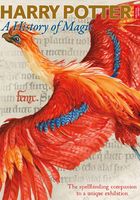

An Apothecary's Sign
Throughout history, the blood, hair and horns of unicorns were believed to possess powerful medicinal properties. Because of their rarity, they commanded very high prices. In The Philosopher's Stone, Voldemort survives on unicorn blood, and potions are made from ‘silver unicorn horn’ that in Diagon Alley costs ‘twenty-one Galleons’ – three times as much as Harry's wand! This 18th-century sign from an apothecary's shop features a very handsome unicorn. The expertly carved sign shows the prosperity of the apothecary and his ability to acquire precious and exotic cures. Although the ivory horn looks like it belongs to a genuine unicorn, this example is actually made from a narwhal's tusk. Known as the ‘unicorn of the sea’, narwhal tusks were often sold and marketed in this way.
‘It's not easy ter catch a unicorn, they’re powerful magic creatures. I never knew one ter be hurt before.’
Harry Potter and the Philosopher's Stone

A PHARMACY SIGN IN THE SHAPE OF A UNICORN’S HEAD (18TH CENTURY)
Science Museum